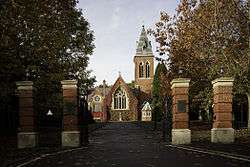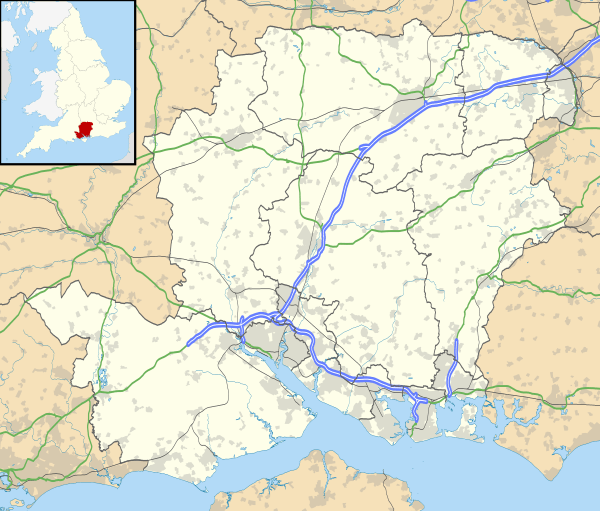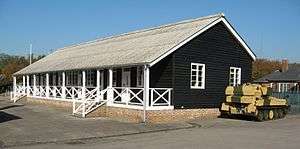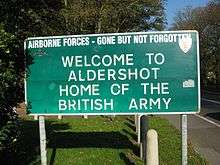Aldershot Garrison
Aldershot Garrison, also known as Aldershot Military Town, is a major garrison in South East England, located between Aldershot and Farnborough in Hampshire. Established in 1854, Aldershot is the home of the British Army although smaller than in previous years. The garrison was established when the War Department bought a large area of land near to the village of Aldershot, with the objective of establishing a permanent training camp for the British Army. Over time, this camp grew into a military town and continues to be used by the Army to the present day. It is home to the headquarters of the Army's Support Command, and it is also the administrative base for the 101st Logistic Brigade. The garrison plays host to around 70 military units and organisations.
| Aldershot Garrison | |
|---|---|
 All Saints Royal Garrison Church | |
 Aldershot Garrison Location within Hampshire | |
| Population | 10,500 |
| District | |
| Shire county | |
| Region | |
| Country | England |
| Sovereign state | United Kingdom |
| Post town | ALDERSHOT |
| Postcode district | GU11 and GU12 |
| Dialling code | 01252 |
| Police | Hampshire |
| Fire | Hampshire |
| Ambulance | South East Coast |
| UK Parliament |
|
In 1972, the garrison was the site of one of the worst UK mainland IRA attacks of the time when a car bomb was detonated outside the headquarters mess of 16 Parachute Brigade. The Official IRA claimed responsibility, stating that the attack was in revenge for the shootings in Derry that came to be known as Bloody Sunday. At the time of the attack, Aldershot garrison was an entirely open garrison. Following the attack the Army took steps to secure the garrison by erecting security fences around most of the barracks and lines, as well as introducing armed security patrols.
The Garrison area covers approximately 500 acres. The total garrison population is about 10,500. Adjacent to the military town is some 2,700 hectares of open military training area. Aldershot Garrison will serve as the hub for the future South East Super Garrison, which will include satellite establishments at Minley, Bordon, Sandhurst, Pirbright, Deepcut, Keogh, Arborfield, Winchester and Worthy Down.
History
Established in 1854, Aldershot has long been seen as the home of the British Army.[1] The garrison was established when the War Department bought a large area of land near to the village of Aldershot, with the objective of establishing a permanent training camp for the British Army. Over time, this camp grew into a military town and continues to be used by the Army to the present day.[1]
Beginnings

Before the establishment of the 'Camp at Aldershot', the British Army did not have any single permanent camp for training troops on a large scale. Historically, troops had been stationed in long established garrisons, many of which could trace their histories back as mediaeval, or earlier, defensive positions. In 1852, following the death of The Iron Duke, a group of reformers, which included Prince Albert, forged an alliance that would seek to improve the training of the Army.[2] In 1853, a summer camp was established at Chobham Common and two divisional size military exercises were conducted. Following the success of these manoeuvres, it was decided that a permanent camp was needed where such exercises could be regularly conducted. Initially, Reigate was selected as a location that was strategically sound, and close enough to London, to defend against invasion from across the English Channel. Despite its obvious advantages, Reigate was situated in prime agricultural land that would prove too expensive to purchase. Lord Hardinge suggested Aldershot Heath as the location for the new training area, as land was less expensive, but still close enough to the South Coast to defend London.[2] In January 1854, the British Government's War Department purchased areas of heathland around the small village of Aldershot at £12 an acre. By 1861, around 8,000 acres had been purchased.[3]
It was originally only envisaged to set up a tented camp for summer use; however, following the outbreak of the Crimean War, it was necessary to accommodate a large number of troops, over a longer period of time and so two hutted camps, one north and one south of the Basingstoke Canal, were constructed. Between 1854 and 1859, around 1,200 wooden huts were constructed by a local civilian contractor, at a cost of £100,263.[4]

Queen Victoria and Prince Albert showed a keen interest in the establishment and the development of Aldershot as a garrison town. In 1855, they had a wooden Royal Pavilion built, in which they would often stay when attending reviews of the Army.[5] In 1860, Prince Albert established and endowed the Prince Consort's Library.[6]
After the Crimean War, a division of regular troops was permanently based at Aldershot, and 'the Division at Aldershot' (including artillery at Christchurch, Hampshire, and cavalry at Hounslow, Middlesex) became one of the most important home commands of the British Army.[7] In January 1876 a Mobilization Scheme for the forces in Great Britain and Ireland was published, with the Active Army divided into eight army corps based on the major Commands and Districts. The 2nd Corps was headquartered at Aldershot. This scheme disappeared in 1881, when the districts were retitled 'District Commands', with Aldershot usually listed as IX or X. In 1898, (when Queen Victoria's son, the Duke of Connaught, was General Officer Commanding) Aldershot Command was ranked I on the list. From 1901 to 1908 Aldershot Command was given the additional title of I Army Corps.[8]
The garrison subsequently became seen as home to the British Army.[1] This status has been reflected in the use of Aldershot as a headquarters for a variety of regional commands over the last 100 years. HQ Aldershot Command continued in existence until c. February 1941, when it was replaced by HQ Aldershot Area.[9]
In the 19th century

In the late 1870s, it was decided that the original hutted camp needed to be replaced with some more permanent structures. When the wooden huts had been built in the 1850s, the contractor had guaranteed the huts for 13 years; in practice, many of those huts were still serving their purpose some 30 years later. In November 1881, the first steps were taken to convert the hutted camp into permanent barracks. At this time, the first two brick buildings were constructed in North Camp; this was quickly followed by the construction of a number of larger brick-built bungalows to replace the previous wooden designs.[10] Government House was built as the garrison commander's house in 1883.[11] Between 1889 and 1893, the remaining wooden buildings, in both North Camp and South Camp, were replaced by brick buildings. Major-General Sir Evelyn Wood had recently been appointed General Officer Commanding at Aldershot and was keen to push forward the building of the new accommodation. It was also, at his request, that a convention for naming the barracks was formulated. Wood advocated that the new barracks should all be named to commemorate famous British victories; initially this proposal met with some resistance, but was eventually adopted. The barracks in Stanhope Lines took names from the famous battles of the Napoleonic Wars and those in Marlborough Lines took names from Marlborough's campaigns.[12] The Military Headquarters Building in Steeles Road was completed in 1895.[13]
In the 20th century
Smith-Dorrien House, the local social facility for soldiers, was completed in 1909.[14] The garrison used to be the corps headquarters for the Royal Corps of Transport and the Army Catering Corps; when these were merged into the Royal Logistic Corps in 1993, the corps headquarters moved to Deepcut Barracks. The garrison was also home to The Parachute Regiment from its formation in 1940 until the regiment moved to Colchester Garrison in 2003. Today, the garrison is home to the headquarters of the Support Command of the British Army, and is also the administrative base for the 145th (South) Brigade and 101st Logistic Brigade. The garrison plays host to around 70 military units and organisations.[15]
1972 IRA bombing
On 22 February 1972, Aldershot experienced one of the worst UK mainland IRA attacks of the time. Seven people, all civilian support staff, including cooks, cleaners, and a Catholic priest, were killed and 19 people were injured, in a car bomb attack on the 16th Parachute Brigade headquarters mess at Aldershot garrison. This blast was later claimed, by the Official IRA, as revenge for the shootings in Derry that came to be known as Bloody Sunday.[16] Until then, the military town had been open-plan, but the attack led to immediate action to secure military property.[17] A memorial stone was placed on the site of the bombing.[17]
In the 21st century
2019–20 coronavirus pandemic
In March 2020, the Ministry of Defence established the COVID Support Force to help tackle the COVID-19 pandemic in the United Kingdom. Command and control of the support force was headquartered in Aldershot Garrison.[18]
Barracks, buildings and geography


Historical military town
Following Aldershot's establishment as a large permanent training camp in the 1850s, the military presence continued to grow. The garrison was divided into the North Camp and the South Camp, either side of the Basingstoke Canal. As more soldiers arrived, they were first housed in bell tents due to a shortage or permanent accommodation. Later, wooden huts were built, which were in turn replaced by brick built barracks in the 1890s. Much of the Victorian camp was demolished in the 1960s.[19]
North Camp
Prior to 1890, Aldershot garrison lacked permanent accommodation to house the growing military presence. Following the Barracks Act of 1890, North Camp was rebuilt with brick barracks named: Blenheim, Lille, Malplaquet, Oudenarde, Ramillies and Tournay. The new barracks were built by Henry Wells, a locally based building contractor. This group of barracks then became known as the Marlborough Lines.[19] Today, the only surviving barracks of the Marlborough Lines group is Lille barracks. The Victorian buildings were largely demolished in 1958, and then rebuilt with more modern facilities, although the original officers' mess survives.[20] North Camp station is the garrison's original railway station.[21]
South Camp
The area known as South Camp was rebuilt at much the same time as North Camp. Construction was completed by the same local company responsible for Marlborough Lines. This phase of construction saw nine barracks built, namely: Albuhera, Barossa, Corunna, Gibraltar, Maida, Buller, Mandora and McGrigor barracks. This group of barracks became known as Stanhope Lines. Many of these brick-build Victorian barracks were demolished in the late 1960s, to make way for what is now Montgomery Lines. One of the Victorian barracks did survive; Clayton barracks is presently used as a transit camp to house soldiers attending Aldershot garrison on courses, or for sporting events and training. Montgomery Lines was completed in the 1970s and was built on the site of several barracks that formerly made up Stanhope Lines. Buller barracks also survives today, although the original Victorian barracks were demolished in the late 1960s, it was rebuilt in the 1970s.[19]
Modern military town

Today, the military town has a population of around 10,500. This consists of around 3,900 resident soldiers, some 1,000 transient military personnel on courses or sport, 770 MoD Civil Servants and some 5,000 service dependents. The garrison contains 2,145 Service Family Accommodation quarters. The rest of the garrison comprises barracks, the Aldershot Military Stadium, Queen's Parade playing fields, Garrison Sports Centre and the Aldershot Centre For Health, which is a joint MoD and local authority venture. The garrison is mostly centred around the crossroads that join Queen's Avenue and Alison's Road. The military town includes local landmarks such as the Aldershot Observatory, Wellington Statue, the RAMC Memorial, Aldershot Military Cemetery, the Royal Garrison Church and other churches. Adjacent to the military town is some 2,700 hectares of open military training area, which is open to the public when not in use for military purposes.[15]
Barracks
Current barracks which encompass the garrison include:
- HQ 11th Infantry Brigade, at Roebuck House[22][23]
- Army Chaplains, 145th (South) Brigade, on Steele's Road (Army Reserve)[24][25]
- Army School of Physical Training, at Fox Gymnasium[26]
- Army Combat Centre, on Queen's Avenue[26]
- Montgomery House (named after Bernard Montgomery)
- Browning Barracks
- Military Preparation College[29]
- Duchess of Kent Barracks (named after the Duchess of Kent)
- 251 Signal Squadron, 10th Signal Regiment, Royal Corps of Signals[23][30]
- Gale Barracks
- Keogh Barracks (named after Lieutenant General Sir Alfred Keogh)
- 22nd Field Hospital, Royal Army Medical Corps[35][36]
- Lille Barracks (named after the Siege of Lille)
- 1st Battalion, Grenadier Guards[23][31]
- Mons Barracks (named after the Battle of Mons)
- 1st Battalion, Scots Guards[31][37]
- Irish Guards (from 2020)[23][38]
- New Normandy Barracks (named after the Battle of Normandy)
- St Omer Barracks (named after the Battle of St Omer-La Bassee)
- Travers Barracks
- Unknown Barracks
- Combat Information Systems (CIS) Troop, 8th Engineer Brigade (Army Reserve)[45][46][24]
- 160 Provost Company, 3rd Regiment, Royal Military Police[47]
- 29 (Explosive Ordnance Disposal & Search) Group, 8th Engineer Brigade[48]
- HQ Specialised Infantry Group
Notes:
- In November 2016, following a review of the defence infrastructure, it was announced that 3 Regt RLC and 27 Regt RLC would remain in their current locations, rather than swapping barracks, as previously announced.[52]
- On 15 December 2016, in a written Parliamentary Answer[53] it was announced that Aldershot would become home to a Specialist Group of infantry battalions: the Royal Scots Borderers, 1st Battalion The Royal Regiment of Scotland; the 4th Battalion The Rifles; the 2nd Battalion The Princess of Wales’s Royal Regiment and the 2nd Battalion The Duke of Lancaster’s Regiment. Meanwhile, 4th Regiment RMP would be rationalised (i.e. disbanded).
Also at Aldershot is the Army School of Physical Training, which is the headquarters of the Royal Army Physical Training Corps.[54]
Future development
South East Super Garrison
In 2010, the Army selected Aldershot garrison as the hub of the new South East Super Garrison, which will include satellite establishments at Minley, Bordon, Sandhurst, Pirbright, Deepcut, Keogh, Arborfield, Winchester and Worthy Down.[55]
Aldershot Urban Extension
Also in 2010, plans were unveiled for local government and planners to redevelop some of the land that comprises the military town according to Aldershot's Urban Extension or 'AUE'.[56]
In literature
The Aldershot Garrison is referenced in the first paragraph of Rudyard Kipling's poem Gunga Din.
See also
- Aldershot 'Glasshouse'
- Aldershot narrow-gauge suspension railway
- List of British Army Garrisons
- List of army barracks around Aldershot
- Aldershot Command
- Letter from Aldershot, a 1942 Canadian propaganda short set at Aldershot Garrison
References
- Origins of the Military Town
- Vickers, Paul H. (2011). Aldershot Military Town—a brief history. Friends of the Aldershot Military Museum. p. 1.
- Cole, Howard N. (1980). The Story of Aldershot. Southern Books. p. 29. ISBN 0-9507147-0-4.
- Vickers, Paul H. (2011). Aldershot Military Town—a brief history. Friends of the Aldershot Military Museum. p. 2.
- Cole, Howard N. (1980). The Story of Aldershot. Southern Books. p. 45. ISBN 0-9507147-0-4.
- Historic England. "Prince Consort's Library (1092600)". National Heritage List for England. Retrieved 13 December 2019.
- Hart's Army List from 1857
- Col John K. Dunlop, The Development of the British Army 1899–1914, London: Methuen, 1938.
- British Military History: Aldershot Command Archived 11 September 2011 at the Wayback Machine
- Cole, Howard N. (1980). The Story of Aldershot. Southern Books. p. 86. ISBN 0-9507147-0-4.
- "Government House Mess, Farnborough". British listed buildings. Retrieved 1 August 2015.
- Cole, Howard N. (1980). The Story of Aldershot. Southern Books. p. 87. ISBN 0-9507147-0-4.
- Historic England. "South East District Headquarters Building of General Officers Commanding (1092611)". National Heritage List for England. Retrieved 30 June 2020.
- Historic England. "Smith-Dorrien House (1375566)". National Heritage List for England. Retrieved 22 December 2019.
- Aldershot Garrison, Introduction Archived 2012-09-28 at the Wayback Machine
- "IRA bomb kills six at Aldershot barracks", bbc.co.uk. Retrieved 1 March 2011.
- "IRA Bombing Victims Remembered In Aldershot 47 Years Later". Forces.net. 22 February 2019. Retrieved 13 December 2019.
- "Military COVID Support Force To Be Overseen From Aldershot". Forces.net. 20 March 2020. Retrieved 21 March 2020.
- Guide to the barracks of Aldershot Archived 2013-12-21 at the Wayback Machine
- History of Lille Barracks Archived 2010-11-15 at the Wayback Machine
- "North Camp". Great Western Railway. Retrieved 13 December 2019.
- "11th Infantry Brigade & HQ South East". www.army.mod.uk. Retrieved 15 July 2020.
- "Regular Army Basing Matrix by Formation and Unit" (PDF). Army Families Federation. Archived from the original (PDF) on 14 August 2016. Retrieved 15 July 2020.
- "Army 2020 Refine Reserves" (PDF). What do they know?. 6 July 2020. Retrieved 15 July 2020.
- "Army Reserve Units". Google My Maps. Retrieved 15 July 2020.
- "ascb sport facilites in Aldershot". www.armysportcontrolboard.org. Retrieved 15 July 2020.
- "Home Command". www.army.mod.uk. Retrieved 15 July 2020.
- "Regional Command". www.army.mod.uk. Retrieved 15 July 2020.
- "Aldershot". MPCT. 3 January 2018. Retrieved 15 July 2020.
- "British Army units from 1945 on - 250 to 253 Squadrons". british-army-units1945on.co.uk. Retrieved 15 July 2020.
- "Order of Battle, Manpower, and Basing Locations". parliament.uk. Retrieved 15 July 2020.
- "Gurkhas face 'Doko' Challenge". www.army.mod.uk. Retrieved 15 July 2020.
- "Army Reserve Units". Google My Maps. Retrieved 15 July 2020.
- "151 Regiment RLC". www.army.mod.uk. Retrieved 15 July 2020.
- "22 Field Hospital". www.army.mod.uk. Retrieved 15 July 2020.
- Cooper, Tim (10 December 2015). "HRH Prince William Awards Military Medics Operational Medals". Forces Network. Retrieved 15 July 2020.
- Cooper, Tim (1 December 2015). "Scots Guards Porridge Oats Make For A Royal Visit Like No Other". Forces Network. Retrieved 15 July 2020.
- at 12:09pm, Laura Hawkins 17 March 2015. "Duke and Duchess of Cambridge Guests of Honour on St Patrick's Day". Forces Network. Retrieved 15 July 2020.
- "Army 2020 Refine Changes" (PDF). assets.publishing.service.gov.uk. 10 March 2017. Retrieved 15 July 2020.
- "6097 Miles Journey for Kohima". Facebook. 22 November 2019. Retrieved 15 July 2020.
- "Specialised Infantry Cadre for B Company". Facebook. 13 September 2019. Retrieved 15 July 2020.
- "British Army units from 1945 on - Princess of Wales' Royal Regiment". british-army-units1945on.co.uk. Retrieved 15 July 2020.
- "101 Logistic Brigade". www.army.mod.uk. Retrieved 15 July 2020.
- "27 Regiment RLC". www.army.mod.uk. Retrieved 15 July 2020.
- "Army Reserve Units". Google My Maps. Retrieved 15 July 2020.
- "Army Reserve Centre, Shoe Loe Aldershot". apply.army.mod.uk. Retrieved 15 July 2020.
- "Award Presentation at 4 RMP, Aldershot". Facebook. 25 November 2016. Retrieved 15 July 2020.
- "Transforming the British Army an Update" (PDF). data.parliament.uk. July 2013. Retrieved 15 July 2020.
- "Specialised Infantry Group". www.army.mod.uk. Retrieved 15 July 2020.
- "Yesterday's Announcement – Royal Regiment of Scotland". Facebook. 16 December 2016. Retrieved 15 July 2020.
- "1 SCOTS Re-subordination Parade". Facebook. 1 October 2017. Retrieved 15 July 2020.
- "A Better Defence Estate" (PDF). Ministry of Defence. November 2016.
- "Strategic Defence and Security Review - Army: Written statement - HCWS367". Ministry of Defence. 15 December 2016.
- "Royal Army Physical Training Corps - How to find us". army.mod.uk. Retrieved 23 October 2016.
- South East Super Garrison Archived 11 October 2010 at the Wayback Machine
- "Aldershot's Urban Extension". Archived from the original on 19 June 2010. Retrieved 27 December 2010.
External links
| Wikimedia Commons has media related to Aldershot Garrison. |